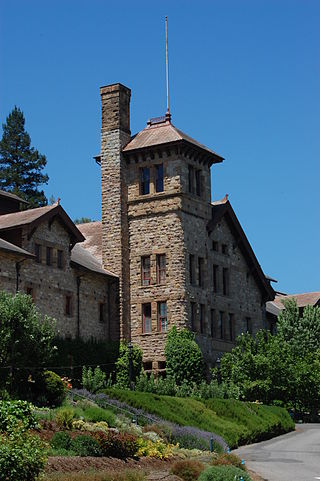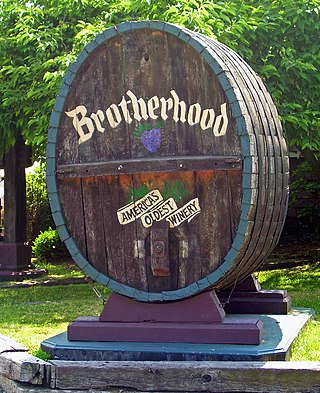
Napa County is a county north of San Pablo Bay located in the northern portion of the U.S. state of California. As of the 2020 census, the population was 138,019. The county seat is the City of Napa. Napa County was one of the original counties of California, created in 1850 at the time of statehood. Parts of the county's territory were given to Lake County in 1861.

Wine Country is the region of California, in the northern San Francisco Bay Area, known worldwide as a premier wine-growing region. The region is famed for its wineries, its cuisine, Michelin star restaurants, boutique hotels, luxury resorts, historic architecture, and culture. Viticulture and wine-making have been practiced in the region since the Spanish missionaries from Mission San Francisco Solano established the first vineyards in 1812.

Robert Gerald Mondavi was an American winemaker. His technical and marketing strategies brought worldwide recognition for the wines of the Napa Valley in California. From an early period, Mondavi promoted labeling wines varietally rather than generically, which became the standard for New World wines. The Robert Mondavi Institute (RMI) for Wine and Food Science at the University of California, Davis opened in October 2008 in his honor.

The Culinary Institute of America (CIA) is an American private college and culinary school specializing in culinary, baking, and pastry arts education. The school's primary campus is located in Hyde Park, New York, with branch campuses in St. Helena and Napa, California; San Antonio, Texas; and Singapore. The college, which was the first to teach culinary arts in the United States, offers associate, bachelor's, and master's degrees, and has the largest staff of American Culinary Federation Certified Master Chefs. The CIA also offers continuing education for professionals in the hospitality industry as well as conferences and consulting services. The college additionally offers recreational classes for non-professionals. The college operates student-run restaurants on its four U.S. campuses.

The Napa River is a river approximately 55 miles (89 km) long in the U.S. state of California. It drains a famous wine-growing region called the Napa Valley, in the mountains north of the San Francisco Bay. Milliken Creek and Mt. Veeder watersheds are a few of its many tributaries. The river mouth is at Vallejo, where the intertidal zone of fresh and salt waters flow into the Carquinez Strait and the San Pablo Bay.

The French Laundry is a three-Michelin star French and Californian cuisine restaurant located in Yountville, California, in the Napa Valley. Sally Schmitt opened The French Laundry in 1978 and designed her menus around local, seasonal ingredients; she was a visionary chef and pioneer of California cuisine. Since 1994 the chef and owner of The French Laundry is Thomas Keller. The restaurant building dates from 1900 and was added to the National Register of Historic Places in 1978.

The Culinary Institute of America at Greystone is a branch campus of the private culinary college the Culinary Institute of America. The Greystone campus, located on State Route 29/128 in St. Helena, California, offers associate degrees and two certificate programs in culinary arts and baking and pastry arts. The CIA at Greystone and the Culinary Institute of America at Copia make up the school's California branch.

The Napa Valley Wine Train is a privately operated excursion train that runs between Napa and St. Helena, California. Much of the rail line parallels State Route 29 after leaving the City of Napa and passes the towns of Yountville, Rutherford and Oakville. The route passes by many of the region's vineyards and wineries located in Napa County.

California wine has a long and continuing history, and in the late twentieth century became recognized as producing some of the world's finest wine. While wine is made in all fifty U.S. states, up to 90% of American wine is produced in the state. California would be the fourth largest producer of wine in the world if it were an independent nation.
Warren Winiarski is a Napa Valley winemaker and the founder and former proprietor of Stag's Leap Wine Cellars.
Miljenko "Mike" Grgić is a Croatian-American winemaker in California. He was born into a winemaking family in the town of Desne on Croatia's coastal region of Dalmatia. He is notable for being the winemaker behind the 1973 Chateau Montelena Chardonnay that bested several white Burgundy wines in the wine tasting event that became known as the Judgement of Paris. In recognition of his contributions to the wine industry, Grgich was inducted into the Culinary Institute of America's Vintner's Hall of Fame on March 7, 2008. The tribute came at the same time that Grgich was celebrating his 50th vintage of winemaking in the Napa Valley.

Gustave Ferdinand Niebaum was a Finnish-American sea captain and winemaker.

Copia: The American Center for Wine, Food & the Arts was a non-profit museum and educational center in downtown Napa, California, dedicated to wine, food and the arts of American culture. The center, planned and largely funded by vintners Robert and Margrit Mondavi, was open from 2001 to 2008. The 78,632-square-foot (7,305.2 m2) museum had galleries, two theaters, classrooms, a demonstration kitchen, a restaurant, a rare book library, and a 3.5-acre (1.4 ha) vegetable and herb garden; there it hosted wine and food tasting programs, exhibitions, films, and concerts. The main and permanent exhibition of the museum, "Forks in the Road", explained the origins of cooking through to modern advances. The museum's establishment benefited the city of Napa and the development and gentrification of its downtown.

The history of American wine began when the first Europeans explored parts of North America, which they called Vinland because of the profusion of grape vines found there. However, settlers would later discover that the wine made from the various native grapes, had flavors which were unfamiliar and which they did not like. This led to repeated efforts to grow familiar Vitis vinifera varieties. The first vines of Vitis vinifera origin were planted in Senecu in 1629, which is near the present day town of San Antonio, New Mexico.

KVON is a commercial AM radio station broadcasting a Spanish AC radio format. Licensed to Napa, California, it serves the Napa County/Sonoma County region of Northern California. The station is owned by Wilfred Alexander Marcencia and Julissa Marcencia, through licensee Wine Down Media LLC.
Napa County wine refers to the viticulture and winemaking in Napa County, California, United States. County names in the United States automatically qualify as legal appellations of origin for wine produced from grapes grown in that county and do not require registration with the United States Department of the Treasury Alcohol and Tobacco Tax and Trade Bureau. The vast majority of Napa County is covered by the boundaries of the world-famous Napa Valley AVA, an American Viticultural Area, and its various sub-appellations. The portion of the county that falls outside of the boundaries of the Napa Valley AVA is northeast of the Chiles Valley AVA, where few grapes are cultivated.

Charles Krug (1825–1892) was among the pioneers of winemaking in the Napa Valley, California, and was the founder of the Charles Krug Winery.

The 2014 South Napa earthquake occurred in the North San Francisco Bay Area on August 24 at . At 6.0 on the moment magnitude scale and with a maximum Mercalli intensity of VIII (Severe), the event was the largest in the San Francisco Bay Area since the 1989 Loma Prieta earthquake. The epicenter of the earthquake was located to the south of Napa and to the northwest of American Canyon on the West Napa Fault.

The history of the Culinary Institute of America (CIA) began in 1946 in New Haven, Connecticut, where it was founded as a vocational institute for returning veterans of World War II. With a growing student body, the Culinary Institute purchased a former Jesuit novitiate in Hyde Park in 1970, which remains its central campus. The school began awarding associate degrees in 1971 and bachelor's degrees in 1993. The school opened its St. Helena campus in 1995, its Texas campus in 2008, its Singapore campus in 2010, and its Napa campus in 2016.
Jackson Family Wines is a wine company headquartered in Santa Rosa, California. At 6 million cases sold per year, it is the ninth-largest wine producer in the United States. Jackson Family Wines includes 40 brands, sourced from vineyards and wineries in California, Oregon, the Bordeaux region in France, Tuscany in Italy, Australia, Chile and South Africa. It controls 50,000 acres (20,000 ha) in the United States and is the largest owner of coastal vineyards in California and Oregon. The family-owned company is known for the brand Kendall-Jackson.
















